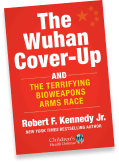8-Year-Old Boy’s ‘Severe’ Headaches Likely Caused by 5G Tower Near School
An 8-year-old developed severe headaches when he started attending a school near a 5G cell tower, according to a new peer-reviewed case study. The findings suggest the high levels of radiofrequency radiation at school caused the boy’s symptoms, the researchers concluded.
Miss a day, miss a lot. Subscribe to The Defender's Top News of the Day. It's free.
A previously healthy 8-year-old boy suffered “severe” headaches when attending a school just 200 meters from a 5G cell tower, according to a new peer-reviewed case study.
The study, published in the Annals of Clinical Case Studies, reported that the Swedish boy — who had no prior history of headaches — also experienced dizziness and fatigue.
The symptoms stopped when the child started wearing a radiofrequency (RF) radiation-blocking cap, jacket and scarf to school.
The report also noted the boy didn’t have the symptoms at home where levels of RF radiation were much lower.
The findings suggest the high levels of RF radiation at school caused the boy’s symptoms, the researchers concluded.
This is the seventh scientific report on the human health effects of real-life 5G by Dr. Lennart Hardell, a leading scientist on cancer risks from radiation, and Mona Nilsson, managing director of the Swedish Radiation Protection Foundation.
Their reports are “provocation” case studies that detail how exposure to 5G RF radiation “provokes” the onset of symptoms, which quickly disappear when the exposure stops or is minimized.
Hardell, an oncologist and epidemiologist with the Environment and Cancer Research Foundation who has authored more than 350 papers — almost 60 of which address RF radiation, believes the global rollout of 5G needs to stop because it’s harming people, especially kids who are “more vulnerable to toxins than adults.”
“A society forcing toxic exposure on innocent people, especially the most sensitive, cannot be accepted,” he told The Defender.
Nilsson agreed. “Children are taking part on a massive scale in a huge and dangerous experiment — without their or their parents informed consent — which may lead to serious long-term consequences,” she told The Defender.
Radiation levels were highest in schoolyard
For the study, the boy’s mother completed a questionnaire about her son’s symptoms at school and at home.
Hardell and Nilsson took repeated measurements of the RF radiation levels at the boy’s school and his home.
At school, the boy developed daily headaches that reached an intensity level of 10, the highest level on a 10-grade scale. He also felt dizzy and tired.
Radiation levels were highest in the schoolyard, ranging from 83,332 to 267,536 microwatts per meter squared (μW/m2). In the classroom and hallway, measurements ranged from 2,560 to 76,590 μW/m2.
The radiation levels at the boy’s home were “considerably lower,” they said, ranging only from 25 to 1,040 μW/m2.
At home, the boy was generally symptom-free with an occasional mild, or level-2, headache that quickly went away. Hardell and Nilsson noted this headache could have been residual from the child’s exposure to high levels of RF radiation at school.
‘As long as radiation hazards are not acknowledged, they go unnoticed’
The boy’s case study is important, the authors said, because many kids are likely experiencing negative symptoms from 5G but don’t associate the symptoms with the technology.
Doctors and parents are generally uninformed about the health hazards associated with RF radiation exposure, so they’re unlikely to consider it a factor when trying to figure out why a child is sick.
“As long as radiation hazards are not acknowledged,” Hardell said, “they are not noticed.”
Adding to the problem is the fact that most countries, including Sweden, have adopted regulatory guidelines and EMF policies recommended by the World Health Organization (WHO) that assume negative health effects only occur when the levels of RF radiation are high enough to heat human tissue, Hardell and Nilsson said.
Such guidelines — including those set by the Federal Communications Commission in the U.S. — don’t take into account long-term exposure to lower levels of radiation, like what’s used in 5G.
Moreover, current regulatory guidelines ignore recent research showing a “clear association between exposure to RF radiation and cancer,” Hardell and Nilsson said.
So not only do current guidelines allow for children like the one in the study to suffer from severe headaches, but the guidelines do nothing to protect kids from possibly developing cancer later in life.
In 2011, the International Agency for Research on Cancer (IARC) at the WHO classified RF radiation as “possibly carcinogenic to humans (Group 2B).” But IARC needs to update that classification based on more recent research, they said.
According to Hardell and Nilsson, RF radiation should be classified as a “human carcinogen, group 1.” And it would be classified that way “if evaluated objectively without conflicts of interests,” they wrote.
“This classification,” they added, “should have a major impact on prevention measures.”
Sign up for free news and updates from Children’s Health Defense. CHD focuses on legal strategies to defend the health of our children and obtain justice for those injured. We can't do it without your support.







No comments:
Post a Comment